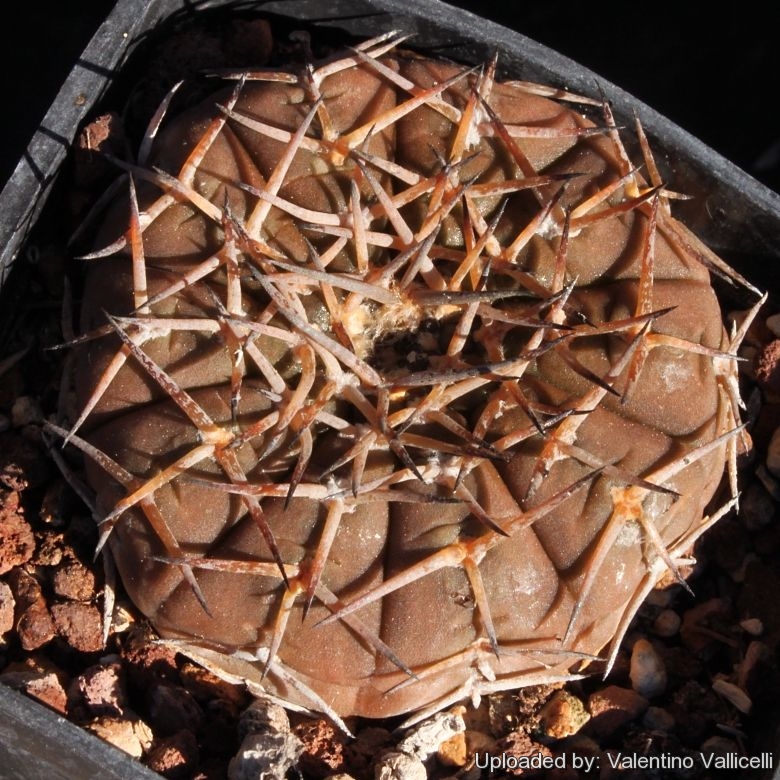Accepted Scientific Name: Gymnocalycium stellatum (Speg.) Speg.
Anales Soc. Ci. Argent. 99: 142 (1925), nom. nov. Notes: Echinocactus stellatus Spegazzini non Scheidw.

Gymnocalycium stellatum var. paucispinum Photo by: Valentino Vallicelli
It forms a flat greyish/brown stem with three strong addpressed spine spines
Origin and Habitat: Argentina (Cordoba, Catamarca)
Synonyms:
See all synonyms of Gymnocalycium stellatum
Description: Gymnocalycium stellatumSN|11493]]SN|11493]] var. paucispinum is a small cactus barely rising above ground level, usually solitary in habitat, but sometime branching basally in cultivation to form clusters. It differs from the standard Gymnocalycium stellatum (a.k.a. Gymnocalycium asterias) for the flat greyish/brown stems with only three stronger addpressed spines in each areole.
Stem: Dark greyish-brown to olive coloured epidermis, flattened globose, 7,5-10 cm in diameter. Will offset after a considerable period of time.
Ribs: 7-11, flat rounded, without prominent chin-like protrusions.
Spines: 3 dark brown, becoming grey with age, add-pressed, usually slightly stronger and longer than in the common forms of Gymnocalycium stellatumSN|11493]]SN|11493]], straight to slightly curved and flattened against the stem
Flowers: Creamy-white with a dull red throat, up to 6,5 cm long, 4,5 cm. diameter.
Fruits: Cylindrical.
Blooming season: Flowers are produced in late spring and remain open for up to twelve days.
Subspecies, varieties, forms and cultivars of plants belonging to the Gymnocalycium stellatum group
Notes: The 'Gymnocalycium asterias ( or asterium)' synonym was recently deemed an illegitimate name during reclassifications, but it is still widely used.
Bibliography: Major references and further lectures
1) Edward Anderson “The Cactus family” Timber Press, Incorporated, 2001
2) David R Hunt; Nigel P Taylor; Graham Charles; International Cactaceae Systematics Group. "The New Cactus Lexicon" dh books, 2006
3) Roberto Kiesling, Omar E. Ferrari “Cien cactus argentinos” Editorial Albatros, 2005
4) N. L. Britton, J. N. Rose “The Cactaceae. Descriptions and Illustrations of Plants of the Cactus Family.” Volume 4, The Carnegie Institution of Washington, Washington 1923
5) Curt Backeberg “Die Cactaceae: Handbuch der Kakteenkunde” Gustav Fischer Verlag, Stuttgart New York 1982–1985
6) James Cullen, Sabina G. Knees, H. Suzanne Cubey "The European Garden Flora Flowering Plants: A Manual for the Identification of Plants Cultivated in Europe, Both Out-of-Doors and Under Glass" Cambridge University Press, 11/Aug/2011.
 Gymnocalycium stellatum var. paucispinum Photo by: Alexander Arzberger
Gymnocalycium stellatum var. paucispinum Photo by: Alexander Arzberger Gymnocalycium stellatum var. paucispinum Photo by: Cactus Art
Gymnocalycium stellatum var. paucispinum Photo by: Cactus Art Gymnocalycium stellatum var. paucispinum Photo by: Cactus Art
Gymnocalycium stellatum var. paucispinum Photo by: Cactus Art Gymnocalycium stellatum var. paucispinum Photo by: Cactus Art
Gymnocalycium stellatum var. paucispinum Photo by: Cactus Art Gymnocalycium stellatum var. paucispinum Photo by: Cactus Art
Gymnocalycium stellatum var. paucispinum Photo by: Cactus Art Gymnocalycium stellatum var. paucispinum Photo by: Cactus Art
Gymnocalycium stellatum var. paucispinum Photo by: Cactus Art Gymnocalycium stellatum var. paucispinum Photo by: Valentino Vallicelli
Gymnocalycium stellatum var. paucispinum Photo by: Valentino Vallicelli Gymnocalycium stellatum var. paucispinum Photo by: Cactus Art
Gymnocalycium stellatum var. paucispinum Photo by: Cactus ArtCultivation and Propagation: Gymnocalycium stellatumSN|11493]]SN|11493]] is supposed to be one of the most difficult species in cultivation, and very slow to get to a reasonable size. It will offset after a considerable period of time.
Soils: It likes very porous standard cactus mix soil. Prefer a low pH compost, avoid substrata rich in limestone; otherwise growth will stop altogether.
Repotting: This plant needs plenty of space for its roots, repotting should be done every other year or when the it has outgrown its pot. Use pot with good drainage.
Watering: It is a summer-growing species that needs regular water in summer, but do not overwater (Rot prone), keep dry in winter at a minimum temperature of 0°C.
Fertilization: Feed with a high potassium fertilizer in summer.
Hardiness: Reputedly resistant to frost if kept on the dry side prior to, and during, cold weather (hardy to -12 C ° C, or less for short periods).
Exposition: The plant tolerates extremely bright situations but enjoys filtered sunlight or afternoon shade, inside it needs bright light, and some direct sun. Tends to bronze in strong light, which encourages flowering and heavy spine production, but is likely to suffer from sun scorch or stunted growth if over exposed to direct sunlight during the hottest part of the day in summer.
Uses: It is an excellent plant for container growing. It always looks good and stays small. It look fine in a cold greenhouse and frame or outdoor in a rockery.
Pests & diseases: It may be attractive to a variety of insects, but plants in good condition should be nearly pest-free, particularly if they are grown in a mineral potting-mix, with good exposure and ventilation. Nonetheless, there are several pests to watch for:
- Red spiders: Red spiders may be effectively rubbed up by watering the plants from above.
- Mealy bugs: Mealy bugs occasionally develop aerial into the new growth among the wool with disfiguring results, but the worst types develop underground on the roots and are invisible except by their effects.
- Scales: Scales are rarely a problem.
- Rot: This species is particularly easy and accommodating, seldom suffer of cryptogamic diseases. Rot it is only a minor problem with gymnocalyciums if the plants are watered and “aired” correctly. If they are not, fungicides won't help all that much.
Propagation: Direct sow after last frost(seldom produces offsets). Seeds germinate in 7-14 days at 21-27° C in spring, remove gradually the glass cover as soon the plants will be well rooted (ca 1-2 weeks) and keep ventilated, no full sun for young plants!
Your Photos

by Cactus Art



















